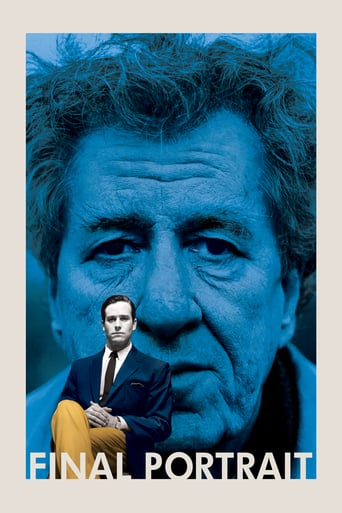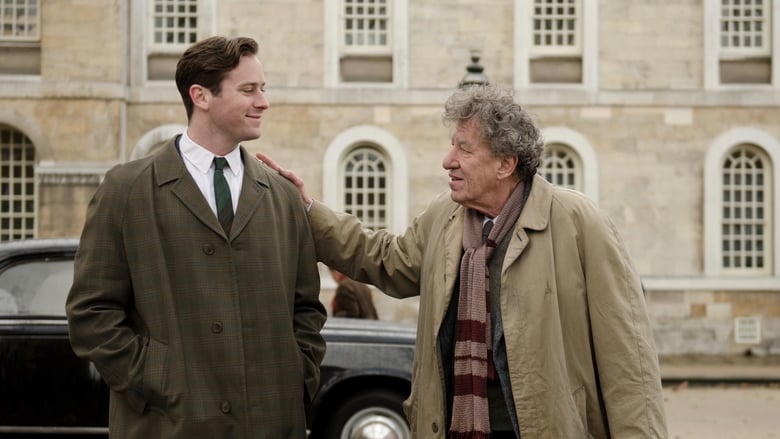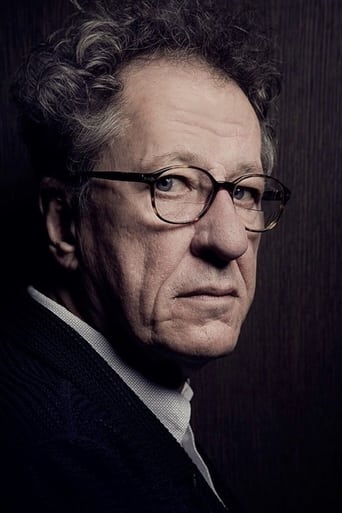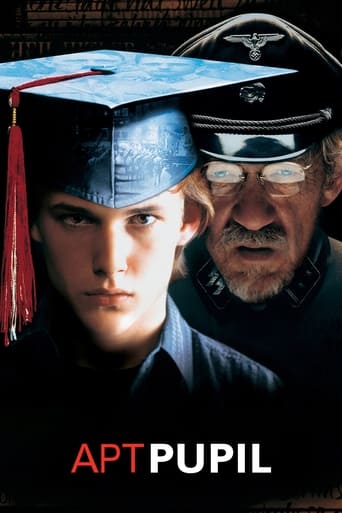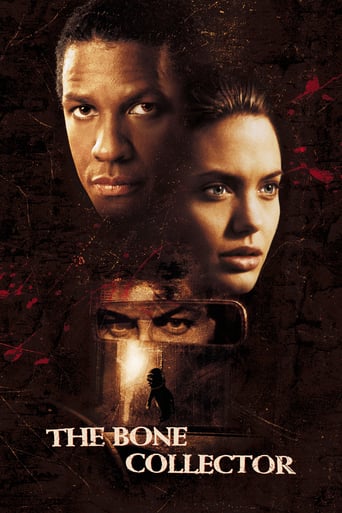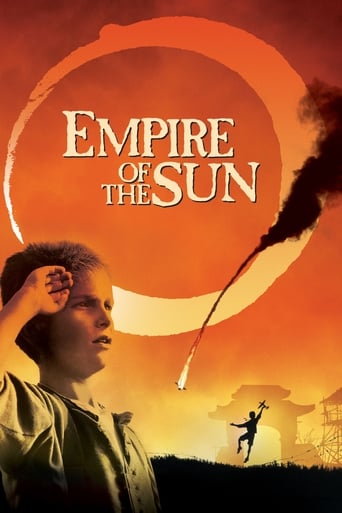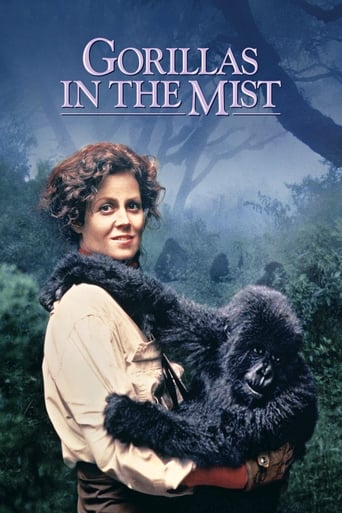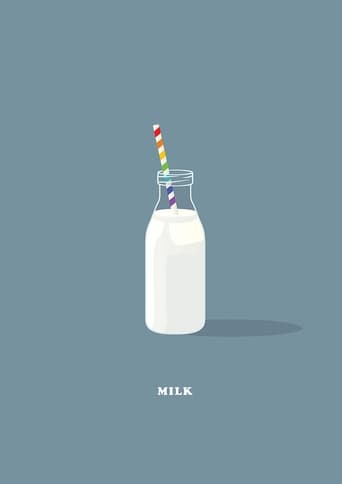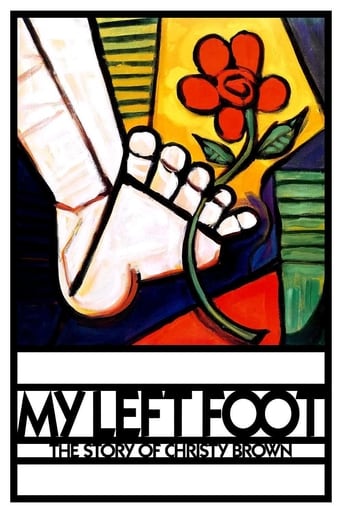Final Portrait (2018)
Paris, 1964. The Swiss sculptor and painter Alberto Giacometti, one of the most accomplished and respected artists of his generation, asks his friend, the American writer James Lord, to sit for a portrait, assuring him that it will take no longer than two or three hours, an afternoon at the most.
Watch Trailer
Cast


Similar titles
Reviews
I managed to watch this movie at home on DVD from my public library. My wife watched the trailer and decided it was not her type of movie.There are a number of very negative reviews and I can understand why. Not a lot happens, it is basically a glimpse of a few days in the life and work habits of Alberto Giacometti, played admirably by Geoffrey Rush. A movie fan not interested in this sort of glimpse probably should not take the time to see it.I went into my viewing completely ignorant of the artist. If the depiction here is faithful, and I believe it is considering the writer/director, the artist was quite an unusual person.The story focuses on what is the last painting the artist did in 1964, just a couple of years before his death. Armie Hammer plays his good friend, American James Lord, who was visiting the artist in Paris. Lord is asked to sit for a portrait before he leaves, the artist saying just an afternoon, maybe 3 or 4 hours. That sitting turned into an 18 day process.Whether one likes or appreciates the work of the artist is immaterial, this movie is a very good glimpse at the life of a very unusual man.
Like most films about an artist, this is about (i) this artist and (ii) The Artist. This artist is the brilliant Swiss/Italian painter/sculptor Alberto Giacometti. Among the several borders he straddles in his work is mankind/existence. His characteristic image - whether in litho, painting or sculpture - is of an impossibly emaciated being, elongated into a teetering vulnerability. His figurative skeletons barely sustain their fragile presence in the antipathetic universe. But they stolidly strive on, with a burning eye or an assertive stride. Yet they barely impinge on their space. That encapsulates postwar European existentialism. The figures are not thin from dieting or starvation but from having been buffeted down and encased by the strictures of human existence. The film recreates Giacometti's studio which teems with recreations of his work. One large white head, bulkier than his typical, looms like a judgment as the characters engage around it and as the artist continually tinkers with his other pieces. Art big, a life small, that one silently asserts. With very little in the way of plot, action, even events, the film's focus is on characterizing Giacometti. The drama his subject James Lord records is Giacometti's insatiable dissatisfaction with his own work. The portrait that should take a day or two stretches into weeks as the artist finds one sense of failure after another, continually whiting over his work to begin anew. What anyone else might deem a success in form and expression, he dismisses because it doesn't achieve his non-apprehensible ideal. A nut bar, obviously, aka Artist. To appease the artist, Lord again and again postpones his flight to New York, even at the risk of the relationship he is compromising by his delays. This Giacometti lives large, everything with a flourish, from his assertive shabbiness to his exaggerated "depositing" of his money. The paradox is that the artist is so effusive in his life but makes such sucked-in, suppressed, creatures in his art. In life he flaunts the obtrusive self, while his art reflects our existential limitations. The two visions respond to each other. Even as he prepares to do a new work or as he rushes out to a bar or a walk, he can't help stopping to do a quick improvement on another piece. And he can never be certain it's an improvement. For its very committing is human, and his own, so necessarily imperfect. Perhaps that's why his every intense day of living is shadowed by the urge to suicide. If only it didn't happen just once.... If only you could repeat it, to improve it.... His quest for that subjective perfection means he can never be satisfied. It also means he keeps growing, changing and taking more risks and achieving greater art. Because he can't be satisfied by his work or by himself, here he trades some of his current more valuable drawings for some earlier - less fashionable, less valuable - works, because he wants to recover something of his old, lost self. The gray old man finds his illusion of romance as fugitive as the vision he pursues in his art - and even more expensive. Hence his absurd overpayment of his mistress's pimps when they come to renegotiate their contract. He raises the price they ask and insists on giving them a large wad to cover the last six months and a larger one for the next. In sex as in art he staves off his mortality. That's living large when you feel human life is so small. For all this individualizing of Giacometti, the film also exercises the modern stereotype of the bohemian artist. Giacometti lives that flamboyance, overriding conventions of art, morality, marriage, social niceties, in compulsive assertion of his self. This is the modern romantic vision of the - of course, necessarily Male - artist. Typically, we get the artist's habitual abuse of his wife, whom he exploits, insults, betrays. Yet he lavishly spoils his mistress, buying her a sports car, and suffers her neglect without a word. You don't have to be of the Me, Too generation to be offended by this. But it helps. He knows the other major artists of his day, of course, but in his own mind and conversation jockeys through gossip to maintain his superiority. An artist needs an ego. How else could he dare to be original? On this theme the film establishes a pointed contrast between Alberto and his artist/designer brother Diego. (Of the lesser known brother Bruno we hear nothing.) Diego has the requisite sensitivity and imagination. He makes a beautiful bird but ruefully acknowledges "It can't fly." But in contrast to Alberto's standard-issue flamboyance, Diego is the quiet, self-effacing worker. He dresses in a shop manager's smock. Instead of the sweeping gesture or challenging extremity, Diego quietly fiddles with things, turning out stuff of value and beauty without any major claims for it. He also avoids Alberto's emotional extremes, indulgences and engagements. Diego's quiet persistence contrasts to Alberto's exuberance. There are other kinds of artist than the stereotype. But it's the Alberto that brings to our much later attention the Diego.
A simple well written and perfectly acted story of an artist and his need to create and make that creation perfect to his liking.Set in the early 1960's the feel and charm of this film is quiet and unrushed to show a time when daily life wasn't as complex and full of the communication distractions we are saddled with today.This story isn't so much about the artist as it is about the artist nearing his final days and facing his needs.Loved it !
Do you really need a model? Some modern art forms and the artists who created them were just so weird. Talents, inspiration, Muse, writer block, painter block, sculptor block....the ways or the twisted ways to look at an object, a dead unmovable thing or a lively human being....Well, you just moved. No, I didn't. Yes, you did....Oh, F@ck! I can't go on, let's do it tomorrow. Okay? Tomorrow would be better. Where should I hide the money? Under the bed? On the beam? You are taller, you do it....No, I can still see it, take it down....Adulteries is the privileged entitlement of an artist, already famous or still struggle to survive. Being abnormal is something great artists usual got, but not autism, yeah?On and on, the questionable obsession of being a model to be painted by a well known artist is just too absurd. But Geoffrey Rush is definitely one of the greatest actors ever be on the screen, a rare treasure that's for sure. "Shine 1996" and "The Best Offer 2013" are the two most memorable films to me. But this film is not what I can swallow easily, what I saw in this film is a troubled mind and soul, very unstable, most of the time just looked like a walking dead, even a mixture of pyscohpath and sociopath, a person with split characters. Do I really want know more about this guy. NO.

